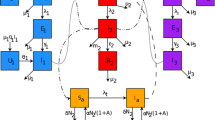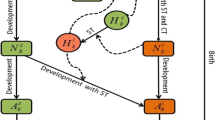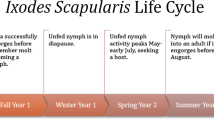Abstract
There exist many tick borne infections that are of either economic or public health interest. Mathematical models have previously been used to describe the dynamics of these infections. However it has recently come to light that there is an alternative mechanism for the transmission of these diseases that has not been considered in a modelling framework. This is transmission through ticks co-feeding on non-viraemic hosts. This paper extends a simple mathematical model to include this alternative transmission mechanism. The model is used to describe the dynamics of Louping ill virus in red grouse (the viraemic host) and hares (the non-viraemic host). However, these results are applicable to many other systems. The model is analysed using joint threshold density curves. It is found that the presence of a non-viraemic host allows the virus to persist more readily than it would in the presence of a host that simply amplified the tick population. More importantly, if the level of non-viraemic transmission is high enough the virus can persist in the absence of the viraemic host. This result has important implications for the control of tick borne diseases.
Similar content being viewed by others
References
Beasley, S.J., Campbell, J.A., Reid, H.W.: Threshold problems in infection of Ixodes ricinus with the virus of Louping ill. Tick borne disease and their vectors. Proceedings of an international conference held in Edinburgh from 27th September to 1st October 1976. Edited by J.K.H Wilde (1978)
Cooksey, L.M., Haile, D.G., Mount, G.A.: Computer simulation of Rocky Mountain Spotted fever transmission by the American dog tick (Acari:ixodidae). J. Med. Ent. 27(4), 671–680 (1990)
Hudson, P.J.: Red Grouse: the biology and management of a wild gamebird. The report of the North of England Grouse Research Project 1977–1985, Game Conservancy Trust, Fordingbridge (1986)
Hudson, P.J.: Grouse in space and time: the population biology of a managed gamebird. The report of the Game conservancy’s Scottish Grouse Research project and North of England Grouse Research project. Game Conservancy Trust Fordingbridge (1992)
Hudson, P.J., Norman, R., Laurenson, M.K., Newborn, D., Gaunt, M., Jones, L., Reid, H., Gould, E., Bowers, R., Dobson, A.: Persistence and transmission of tick-borne viruses: Ixodes ricinus and louping-ill virus in red grouse populations. Parasitology 111, 549–558 (1995)
Jenkins, D., Watson, A., Miller, G.R.: Population fluctuations in the red grouse Lagopus lagopus scoticus. J. Anim. Ecol. 36, 97–122 (1967)
Jones, L.D., Davies, C., Steele, G.M., Nuttall, P.A.: A novel mode of arbovirus transmission involving a non-viraemic host. Science 237, 775–777 (1987)
Jones, L.D., Davies, C.R., Williams, T., Cory, J., Nuttall, P.A.: Non-viraemic transmission of Thogoto virus- vector efficiency of Rhipicephalus appendiculatus and Amblyomma variegatum. Trans. Roy.Soc Trop.Med. Hyg. 84(6), 846–848 (1990)
Jones, L.D., Kaufman, W.R., Nuttall, P.A.: Modification of the skin feeding site by tick saliva mediates virus transmission. Experientia 48(8), 779–782 (1992)
Jones, L.D., Gaunt, M., Hails, R.S., Laurenson, K., Hudson, P.J., Reid, H., Henbest, P., Gould, E.A.: Efficient transfer of Louping ill virus between infected and uninfected ticks co-feeding on mountain hares (Lepus timidus). Med. Vet. Entomol. 142(6), 1181–1191 (1997)
Labuda, M., Jones, L.D., Williams, T., Nuttall, P.A.: Enhancement of tick-borne encephalitis transmission by tick salivary gland extracts. Med. Vet. Entomol. 7(2), 193–196 (1993a)
Labuda, M., Nuttall, P.A., Kozuch, O., Eleckova, E., Williams, T., Zuffova, E., Sabo, A.: Non-viraemic transmission of tick-borne encephalitis virus: a mechanism for arbovirus survival in nature. Experientia 49, 802–805 (1993b)
Norman, R., Bowers, R.G., Begon, M., Hudson, P.J.: Persistence of tick borne virus in the presence of multiple host species: ticks act as reservoirs and result in parasite mediated competition. J. Theor. Biol. 200, 111–118 (1999)
O’Callaghan, C.J., Medley, G.F., Peter, T.F., Perry, B.D.: Investigating the epidemiology of heartwater (Cowdria ruminantium infection) by means of a transmission dynamics model. Parasitology 117, 49–61 (1998)
Ogden, N.H., Nuttall, P.A., Randolph, S.E.: Natural Lyme disease cycles maintained via sheep by cofeeding ticks. Parasitology 115(6), 591–599 (1997)
Randolph, S.E., Gern, L., Nuttall, P.A.: Co-feeding ticks, Epidemiological significance for tick-borne pathogen transmission. Parasitology Today 12(12), 472–479 (1996)
Reid, H.W.: Experimental infection of red grouse with Louping ill virus (flavivirus group) I. The viraemia and antibody response. J. Comp. Path. 85, 223–229 (1975)
Reid, H.W.: The epidemiology of Louping ill. In: Wilde, J.K.H. (ed.), Tick Borne Disease and their Vectors. Proceedings of an International Conference held in Edinburgh 27th September to 1st October 1976 (1978)
Sonenshine, D.E., Mather T.N.: Ecological dynamics of tick-borne zoonoses. O.U.P New York (1994)
Author information
Authors and Affiliations
Corresponding author
Rights and permissions
About this article
Cite this article
Norman, R., Ross, D., Karen Laurenson, M. et al. The role of non-viraemic transmission on the persistence and dynamics of a tick borne virus – Louping ill in red grouse (Lagopus lagopus scoticus) and mountain hares (Lepus timidus). J. Math. Biol. 48, 119–134 (2004). https://doi.org/10.1007/s00285-002-0183-5
Received:
Published:
Issue Date:
DOI: https://doi.org/10.1007/s00285-002-0183-5




